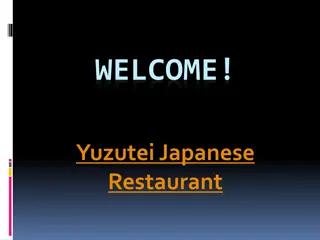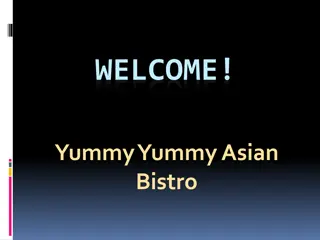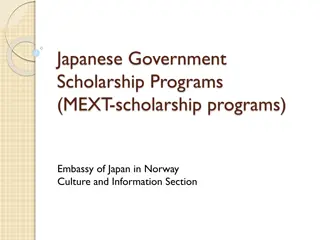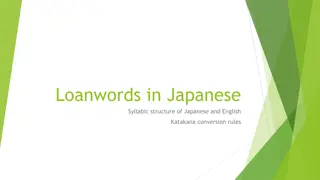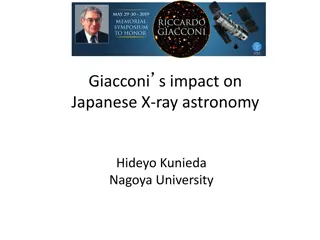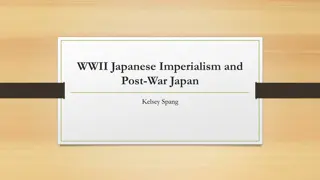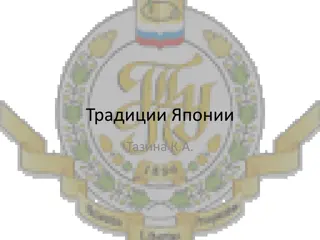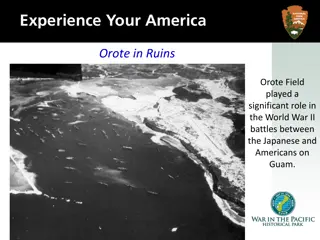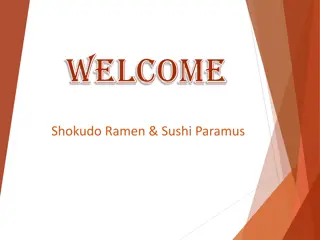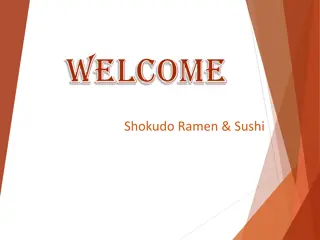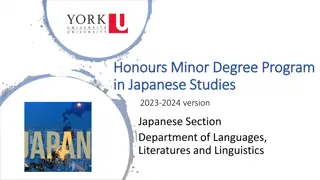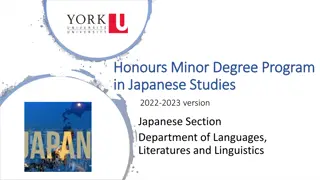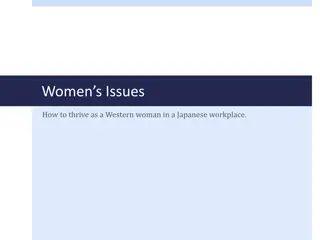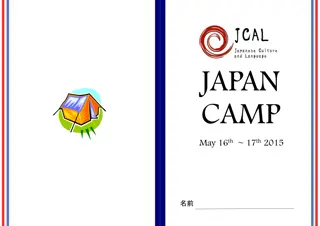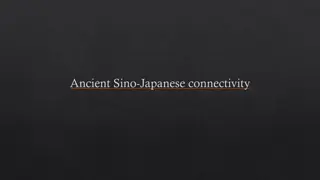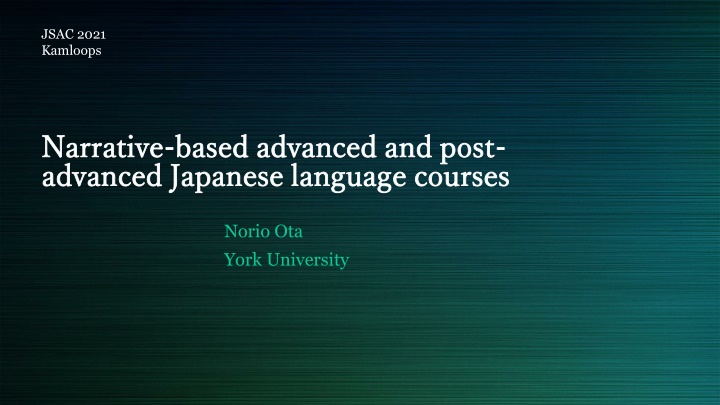
Establishing a Full Four-Year Japanese Language Program
Language education in university settings is explored with a focus on Japanese language programs. Objectives include integrating language courses as integral parts of education, implementing effective teaching strategies, and developing sustainable online course designs. Narratives and narrative theory play key roles in human understanding and communication, emphasizing the importance of storytelling in making sense of the world. The narrative paradigm by Walter Fisher contrasts human storytelling with rational decision-making, highlighting the power of stories in shaping our perceptions and choices.
Download Presentation

Please find below an Image/Link to download the presentation.
The content on the website is provided AS IS for your information and personal use only. It may not be sold, licensed, or shared on other websites without obtaining consent from the author. If you encounter any issues during the download, it is possible that the publisher has removed the file from their server.
You are allowed to download the files provided on this website for personal or commercial use, subject to the condition that they are used lawfully. All files are the property of their respective owners.
The content on the website is provided AS IS for your information and personal use only. It may not be sold, licensed, or shared on other websites without obtaining consent from the author.
E N D
Presentation Transcript
JSAC 2021 Kamloops Narrative Narrative- -based advanced and post based advanced and post- - advanced Japanese language courses advanced Japanese language courses Norio Ota York University
Objectives in Japanese Language Education Establish a full four-year Japanese language program Investigate how a language program can be an integral part of university education Explore sustainable and progressive teaching strategies for IT-based course design for the future
Language education in university education Are language courses qualified as necessary and indispensable parts of education? Are language professionals consciously implementing the said benefits of language learning through teaching and instructional materials, and indeed are students acquiring them? What kind of new approaches are necessary to design and develop viable, sustainable and progressive advanced and post-advanced courses, particularly for online course delivery?
Narrative? a way of presenting or understanding a situation or series of events that reflects and promotes a particular point of view or set of values (Merriam Webster) https://www.merriam-webster.com/dictionary/narrative Narrative Theory (Project Narrative, OSU) Narrative theory starts from the assumption that narrative is a basic human strategy for coming to terms with fundamental elements of our experience, such as time, process, and change, and it proceeds from this assumption to study the distinctive nature of narrative and its various structures, elements, uses, and effects. Narrative theorists, in short, study how stories help people make sense of the world, while also studying how people make sense of stories. Narratives of all kinds are relevant to the field: literary fictions and nonfictions, film narratives, oral narratives occurring during the give and take of everyday conversation, as well as narrative told in courtrooms, doctor s offices, business conference rooms indeed anywhere.
Walter Fishers Narrative paradigm Narrative paradigm 1. Humans are storytellers. 2. Decision making and communication are based on "good reasons". 3. Good reasons are determined by matters of history, biography, culture and character. 4. Rationality is based in people's awareness of internal consistency and resemblance to lived experience. Rational world paradigm 1. Humans are rational. 2. Decision making is based on arguments. 3. Arguments adhere to specific criteria for soundness and logic. 4. Rationality is based on the quality of evidence and formal reasoning processes. 5. The world can be understood as a series of logical relationships that are uncovered through reasoning. 5. We experience a world that is filled with stories, and we must choose among them. wiki
Narrative in language education The importance of narrative activity and analysis in foreign language teaching and learning has been discussed by scholars in ESL and in Japanese language education. Mori (2008) emphasizes the importance of learners narrative activities as an integral part of communicative approach. Shimazu (2018) argues that practice of narrative for both learners and teachers is important in constructing and presenting their identities. Yagi (2015) claims that fusion of narrative and ethnography will help learners to construct identities in the global and multi-cultural environment. Fedorenko, et al. (2021) argue that multimodality, grounded on information technologies, is introducing entirely new semiotic resources into the communicative environment of foreign language learning. It is also generating innovative ways and forms of oral and written interaction. Their sample multimodal learning activities in ESL are very innovative and instructive. They conclude, Multimodal learning activities enhance the methodology of foreign language acquisition. Summing up, the educational environment with a digital technologies of transformation, storage and transfer of information creates a powerful source of knowledge, and, apparently, allows the students to get the practical application of a new multimodal narrative- based approach to actualize their creative talent.
Multimodality and Digital Narrative (Fedorenko et al.) .it is necessary to stress that the multimodality of the 21st century has changed traditional approaches to teaching a foreign language. The speech activities (reading, listening, speaking and writing) remain the same, while the forms have transformed, as multimodal capabilities allow exploiting presentations, videos, blogs, etc. Such process requires a new communicative discourse of learning a foreign language. Nowadays, it is becoming increasingly popular in a multimodal environment of learning a foreign language to turn to an interactive digital narrative. Since, on the one hand, the digital narrative is characterized by interdiscplinarity, and, on the other, - enhances the development of students critical and creative thinking, communication skills, and digital competence. Awareness of the importance of narrative as a way of understanding the world around us and ourselves in this world has led to rethinking the educational process in general, and learning a foreign language in particular. Narratives involve not just the presentation of students thoughts about a particular event, deed, etc., but contain a transfer of their attitudes to what they describe. At the same time, reflection becomes an integral attribute of the narrative as a sociocultural tool that provides students with deeper self- understanding, and complements the communicative system of foreign language acquisition with metacognition and values of life meaning.
Narrative-based Course design Jp3000 Advanced modern standard Japanese Jp4000 Post-advanced modern standard Japanese https://buna.yorku.ca/japanese/jp3000.html https://buna.yorku.ca/japanese/jp4000.html Developing and teaching online courses for advanced and post advanced levels brought forward a small breakthrough in conceptualizing a model for both. The key concept is narrative. For example, in jp4000 post-advanced modern standard Japanese, one of the narratives was critical view of neo-liberalism. Students read an article, watch a lecture and related YouTube discussion, engage in a discussion in a small group, and write an essay on the same theme. Some of the students comments included that they had learned about neoliberalism in other courses, but studying about it in Japanese helped to understand it more clearly.
What is expected for language professionals? 1. Improve their narrative skills both in Japanese and English. 2. Identify issues, become familiar with them and have one s own opinions and narrative. 3. Understand each student s narrative ethnographically and globally to encourage her/him to construct their identities in Japanese. 4. Share one s own life experience and values with students. 5. Create one s own narratives for instructional material.
Future prospect We are living in Toffler s 3rd Wave civilization. Some talk about 4th Wave and even 5th wave, characterized by IoT (the Internet of Things). (Montgomery, 2016) Futurists also predict technological horizon will take place by the year 2035, in which AI would control every aspect of human life and diminish any differences in intelligence, skills, knowledge, talents among people, because no one would be able to surpass the power and knowledge of AI. We very often wonder whether or not teaching profession would also be taken over by AI eventually. This may be a far-fetched conclusion, but this narrative-approach would make a breakthrough in maintaining human factors in teaching. Wishful thinking???
Conclusion The number of narratives are infinite and changing all the time, so we can design and create new advanced and post-advanced courses constantly using varieties of narratives. I feel that this is the new beginning of such advanced and post- advanced level courses, although it may be a little too late for me. Thank you very much for your attention.
References Fedorenko, Svitolana, et al. (2021) Multimodality and Digital Narrative in Teaching a Foreign Language , Arab World English Journal (AWEJ) Special Issue on CALL Number 7. July 2021, pp.178-189, https://dx.doi.org/10.24093/awej/call7.13 Hazel, Paul (2007) Narrative: An Introduction , http://www.paulhazel.com/blog/Introduction_To_Narrative.pdf Montgomery, Bill (2016) The 5th Wave , Th IOT Magazine, Oct 26, 216, https://theiotmagazine.com/the- 5th-wave-4ee1ad8b3e9e (2008) 18, pp. 17-32, http://id.nii.ac.jp/1443/00005871/ Ota, Norio (2010) Textbook dominance in foreign language teaching and learning , paper presented at the 2010 Power & Knowledge Conference, Tampere, Finland, September 6-8, 2010. _________ (2014a) Washback and paradigm shift the post-communicative paradigm with technology , paper presented at the 12th Hawaii International Conference on Arts and Humanities, Honolulu, Hawaii, January 10-13, 2014.
Reference (cont.) _________ (2014b) Making of a degree program in Japanese Studies , paper presented at the 2014 JSAC Annual Conference, Ryerson University, Toronto. October 17-19, 2014. _________ (2016) Standardization vs. innovation in language education , in Globalizing Japan: Issues in Language, Linguistics and Japanese Society edited by D. Edgington, 2016, http://www.jsac.ca/jsac_web_pub/issrs_2015_pub_tokyo.pdf (2018) 16 pp. 55-62, http://alce.jp/journal/ Wikipediea (2017) Narrative Paradigm , https://en.wikipedia.org/wiki/Narrative_paradigm (2015) 162, pp.50-65, https://www.jstage.jst.go.jp/article/nihongokyoiku/162/0/162_50/_article/-char/ja

